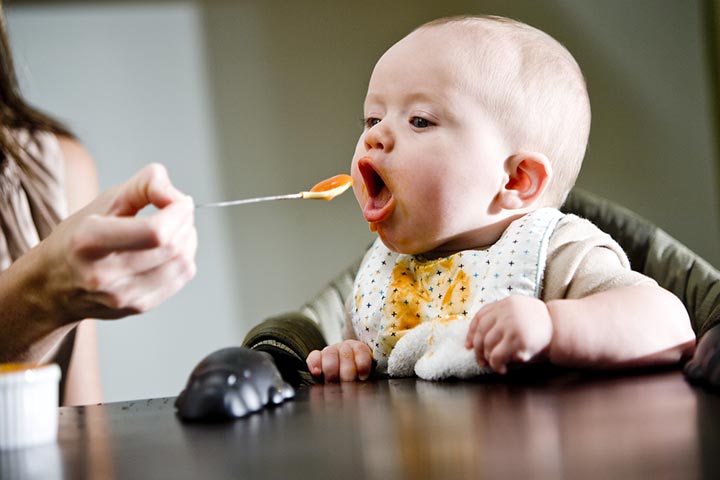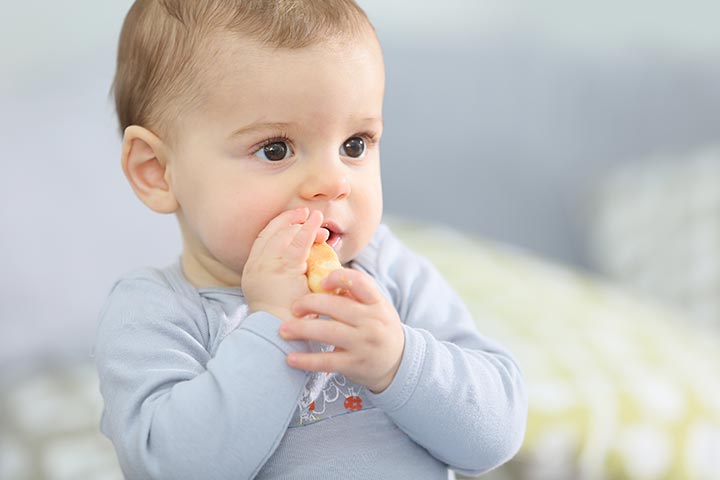
Image: Shutterstock
The biggest challenge a first-time parent faces is feeding your infant. From breastfeeding to running behind your baby with a bowl of cereal, the journey is rather exhausting! For the first six months, all your baby needs is breast milk or formula. After that, you need to start the weaning process and introduce foods according to their readiness. It is essential to keep the food prepared with simple ingredients. It can be fruits, vegetables, and even meat. By the time your baby is 8-12 months old, they will drool over your plate of food and try to experiment with something you are eating. It is normal for parents to be confused with baby food recipes as kids get bored with food quickly. Here is a feeding guide to how you should introduce food to your baby in the first year. Read on to know them all.
Birth To 4 Months
Image: Shutterstock
A newborn baby depends totally on the mother’s milk or formula. Their digestive system is still developing, and they can’t process any solid food. Your baby will turn to your nipple the moment they are hungry.
4 To 6 Months
Image: Shutterstock
Your baby will give signs of interest in solid foods by this time. You can introduce a bite of semi-solid only when they are sitting straight on a chair and in adult supervision. If you are unsure if your baby is ready for solid food, you can bring a tiny spoon of food near their mouth and see if they are drawn towards it. Also, make sure your baby is at least 13 pounds before giving them solid foods. This is when you can introduce foods like pureed vegetables, fruits, meat, semi-liquid food, iron-fortified cereals, and unsweetened yogurt along with breast milk. Also, when introducing the semi-solids, make sure you do it in tiny amounts, and not more than one or two spoons per meal.
Pro Tip: If you feel your baby will gobble up the food on the first go, you are in for some serious disappointment. However, don’t give up just yet. You have to keep trying until they develop a taste for it in the next few days.
Doctors also recommend introducing one food at a time and then taking a break of 3-5 days before giving something new. This is important so you know what foods are giving your baby allergies. If the parents show allergic symptoms to any food, it’s better to avoid the food in the first few months.
Also, if any store-bought food contains toxic heavy metals like lead, arsenic, mercury, and cadmium, it is best to not bring that food home.
6 To 8 Months
Image: Shutterstock
This is when your baby will like to put their hands on your plate and maybe even take a bite of the french fry. You can try fruit puree like pear, banana, peaches, applesauce, and avocado. Even puree vegetables like sweet potato, carrots, and squash work well with kids. If you want, you can try mashed meat and tofu. Do not give cow’s milk to your baby until they are one. And in parallel to your semi-solid food, you should keep feeding breast milk or formula as kids have difficulty drinking water.
Here is how much food your child should have per day
- 3-5 feedings of breastfeeding or formula.
- 2-3 spoons fruit pulp
- 2-3 spoons vegetable puree
- 1-2 spoons mashed grains
- 1-2 spoons of meat puree
As your baby accepts this, you can gradually increase the number of spoons to 4-8 per day. Also, you can increase the frequency of meals. Your baby should be eating 1-2 meals a day by the eighth month.
Make sure you give enough time to your baby to get used to the food texture. Also, never force-feed your child. Your baby will eat when they are hungry and stop when they are full. Forcing food on them can lead to unhealthy eating disorders.
8 To 12 Months
Image: Shutterstock
This is when you can transition from puree to soft solid food. Kids this age love finger food and want to put the food in their mouths on their own. They also learn how to move the jaw for chewing and swallow food quickly. You will also find your kids trying to take the spoon on their own and eat with it. Continue with breast milk or formula and introduce pasteurized cheese, unsweetened yogurt, soft cooked vegetables, mashed or cut fruits. Kids also enjoy finger foods like scrambled eggs, well-cooked pasta, crackers, eggs, boneless fish, beans, and beagles.
Keep the breastfeeding or formula to 4 feedings a day. Other foods should be fed as the following-
- 3/4 cup of chopped fruits
- 3/4 cup of chopped and boiled vegetables
- 1/2 cup grain products
- 1/4 cup protein foods
By their first birthday, they will be able to eat all simple solid foods. The best way to inculcate good eating habits is to eat healthy before your kids. Also, keep sugary products out of your kid’s vicinity. There will come a time when your child will discover ice cream and chocolate, but it should be a treat that they get only on special occasions or weekends. By introducing healthy food habits, you will bestow a healthy life upon your children.
















